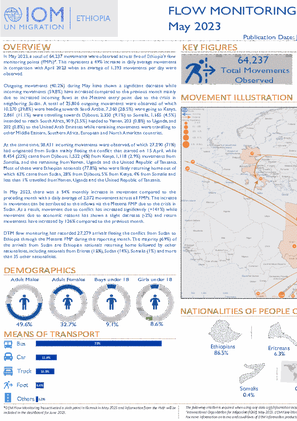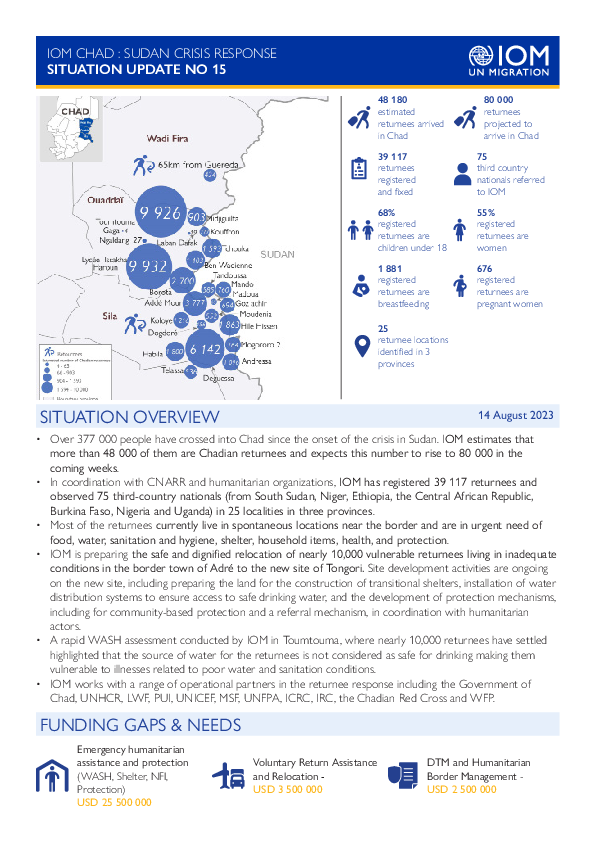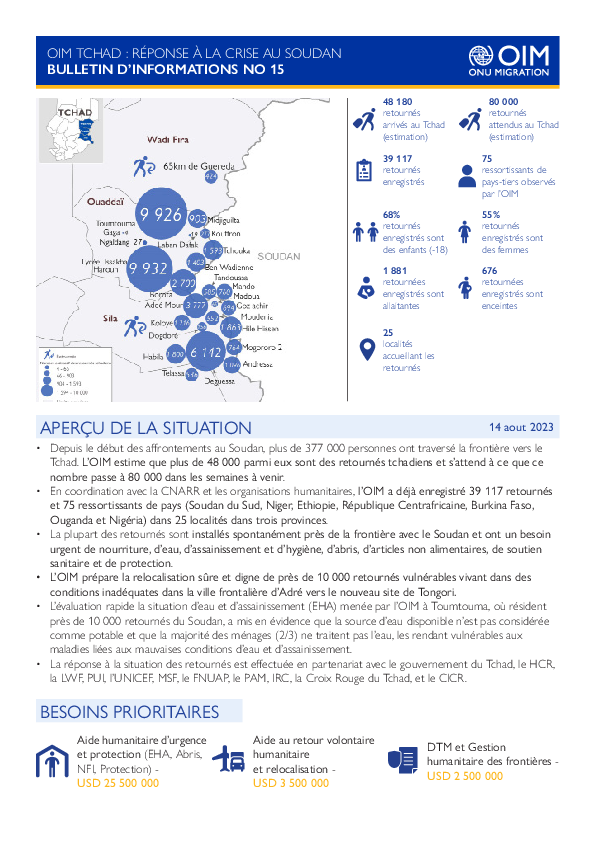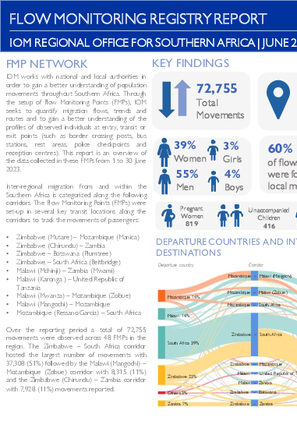-
Countries
-
Data and Analysis
-
Special Focus
-
Crisis Responses
Contact
DTM Sudan, DTMSudan@iom.int
Location
Sudan
Activity
- Mobility Tracking
- Baseline Assessment
Period Covered
May 19 2023 -Aug 13 2023
The current total estimate of recently displaced individuals across Sudan has reached 3,433,025 Individuals (685,657 Households).
The current assessment has observed the IDP caseload in all of Sudan’s 18 states. The highest proportions of IDPs have been observed in River Nile (14.59%), Northern (10.55%), Sennar (8.22%), White Nile (8.15%), and North Darfur (8.01%).
Field teams report that the IDPs observed were originally displaced from eight states. The majority (2,553,817 IDPs representing 74.39%) have been reportedly displaced from Khartoum state; followed by North Darfur (8.10%), South Darfur (7.43%), West Darfur (4.80%), Central Darfur (4.28%), North Kordofan (0.51%), South Kordofan (0.48%), and Aj Jazirah (0.01%).
In addition to the internal displacement, the conflict in Sudan has caused the Mixed Cross-Border Movements of 1,017,449 individuals into neighbouring countries.
Population Groups
Survey Methodology
Unit of Analysis Or Observation
Type of Survey or Assessment
Keywords
Geographical Scope
Administrative boundaries with available data
The current dataset covers the following administrative boundaries
Monthly Overview of:
- Arrivals in the Western Balkans
- Top three nationalities at arrivals in the reporting month
- Migrants presence in reception facilities
- Migrants presence outside reception facilities
- Returns and reintegration

Contact
dtmhaiti@iom.int
Language
English
Location
Haiti
Period Covered
Aug 12 2023
Aug 15 2023
Activity
- Mobility Tracking
- Event Tracking
Since 12 August 2023, the neighborhoods of Carrefour-Feuilles and Savanes Pistaches, located in the municipality of Port-au-Prince (West Department) have been affected by armed violence. To date, approximately 1,020 households (4,972 individuals) have been displaced, most of whom (76%) have taken refuge in 13 sites and the rest in host communities.
IOM works with national and local authorities in order to gain a better understanding of population movements throughout Southern Africa. Through the setup of Flow Monitoring Points (FMPs), IOM seeks to quantify migration flows, trends and routes and to gain a better understanding of the profiles of observed individuals at entry, transit or exit points (such as border crossing posts, bus stations, rest areas, police checkpoints and reception centres). This report is an overview of the data collected in these FMPs from 1 to 30 June 2023.
Inter-regional migration from and within the Southern Africa is categorized along the following corridors. The Flow Monitoring Points (FMPs) were set-up in several key transit locations along the corridors to track the movements of passengers:
•Zimbabwe (Mutare) – Mozambique (Manica)
•Zimbabwe (Chirundu) – Zambia
•Zimbabwe – Botswana (Plumtree)
•Zimbabwe – South Africa (Beitbridge)
•Malawi (Mchinji) – Zambia (Mwami)
•Malawi (Karonga ) – United Republic of Tanzania
•Malawi (Mwanza) – Mozambique (Zobue)
•Malawi (Mangochi) – Mozambique
•Mozambique (Ressano Garcia) – South Africa
Over the reporting period a total of 72,755 movements were observed across 48 FMPs in the region. The Zimbabwe – South Africa corridor hosted the largest number of movements with 37,308 (51%) followed by the Malawi (Mangochi) – Mozambique (Zobue) corridor with 8,315 (11%) and the Zimbabwe (Chirundu) – Zambia corridor with 7,928 (11%) movements reported.
Contact
DTM Sudan, DTMSudan@iom.int
Location
Sudan
Activity
- Mobility Tracking
- Baseline Assessment
Period Covered
May 19 2023 -Aug 13 2023
The current total estimate of recently displaced individuals across Sudan has reached 3,433,025 Individuals (685,657 Households).
The current assessment has observed the IDP caseload in all of Sudan’s 18 states. The highest proportions of IDPs have been observed in River Nile (14.59%), Northern (10.55%), Sennar (8.22%), White Nile (8.15%), and North Darfur (8.01%).
Field teams report that the IDPs observed were originally displaced from eight states. The majority (2,553,817 IDPs representing 74.39%) have been reportedly displaced from Khartoum state; followed by North Darfur (8.10%), South Darfur (7.43%), West Darfur (4.80%), Central Darfur (4.28%), North Kordofan (0.51%), South Kordofan (0.48%), and Aj Jazirah (0.01%).
In addition to the internal displacement, the conflict in Sudan has caused the Mixed Cross-Border Movements of 1,017,449 individuals into neighbouring countries.
Population Groups
Survey Methodology
Unit of Analysis Or Observation
Type of Survey or Assessment
Keywords
Geographical Scope
Administrative boundaries with available data
The current dataset covers the following administrative boundaries

Contact
DTM Ethiopia, DTMEthiopia@iom.int
Language
English
Location
Ethiopia
Period Covered
May 01 2023
May 31 2023
Activity
- Flow Monitoring
In May 2023, a total of 64,237 movements were observed across five of Ethiopia's flow monitoring points (FMPs). This represents a 49% increase in daily average movements in comparison with April 2023 when an average of 1,393 movements per day were observed.
Outgoing movements (40.2%) during May have shown a significant decrease while incoming movements (59.8%) have increased compared to the previous month mainly due to increased incoming flows at the Metema entry point due to the crisis in neighboring Sudan. A total of 25,806 outgoing movements were observed of which 10,270 (39.8%) were heading towards Saudi Arabia, 7,360 (28.5%) were going to Kenya, 2,861 (11.1%) were travelling towards Djibouti, 2,350 (9.1%) to Somalia, 1,165 (4.5%) intended to reach South Africa, 909 (3.5%) headed to Yemen, 203 (0.8%) to Uganda, and 202 (0.8%) to the United Arab Emirates while remaining movements were travelling to other Middle Eastern, Southern African, European and North American countries.
At the same time, 38,431 incoming movements were observed, of which 27,290 (71%) had originated from Sudan mainly fleeing the conflict that started on 15 April, while 8,454 (22%) came from Djibouti, 1,522 (4%) from Kenya, 1,118 (2.9%) movements from Somalia, and the remaining from Yemen, Uganda and the United Republic of Tanzania. Most of these were Ethiopian nationals (77.8%) who were likely returning home out of which 63% came from Sudan, 28% from Djibouti, 5% from Kenya, 4% from Somalia and less than 1% travelled from Yemen, Uganda and the United Republic of Tanzania.

Contact
DTM Sudan, DTMSudan@iom.int
Language
English
Location
Sudan
Snapshot Date
Aug 09 2023
Activity
- Mobility Tracking
- Baseline Assessment
Overview
From 15 April 2023, armed clashes erupted between the Sudanese Armed Forces (SAF) and the Rapid Support Forces (RSF) in multiple cities across Sudan. Clashes initially took place in cities across Northern and Khartoum states, later spreading across the Darfur and Kordofan regions. Since Situation Report 16, the field team has reported outbreaks of violence across Um Kadadah locality in North Darfur, as well as Nyala Janoub locality and Kubum locality in South Darfur.
Highlights
- The current total estimate of recently displaced individuals across Sudan has reached 3,433,025 Individuals (685,657 Households).
- The current assessment has observed the IDP caseload in all of Sudan’s 18 states. The highest proportions of IDPs have been observed in River Nile (14.59%), Northern (10.55%), Sennar (8.22%), White Nile (8.15%), and North Darfur (8.01%).
- Field teams report that the IDPs observed were originally displaced from eight states. The majority (2,553,817 IDPs, 74.39%) have been reportedly displaced from Khartoum state; followed by North Darfur (8.10%), South Darfur (7.43%), West Darfur (4.80%), Central Darfur (4.28%), North Kordofan (0.51%), South Kordofan (0.48%), and Aj Jazirah (0.01%).
- In addition to the internal displacement, the conflict in Sudan has caused the Mixed Cross-Border Movements of 1,017,449 individuals into neighbouring countries.
Contact
DTMUkraine@iom.int
Location
Ukraine
Activity
- Mobility Tracking
- Baseline Assessment
Period Covered
Jul 01 2023 -Jul 31 2023
The data collected for the Area Baseline Assessment Round 26 reflects the up-to-date local administrative register of the IDP population as of 31 July 2023, equivalent to a total of 3,677,601 registered IDPs. Among oblasts, Kharkivska (510,775), Dnipropetrovska (388,845) and Kyivska (334,148) have the highest number of officially registered IDPs.
Population Groups
Survey Methodology
Unit of Analysis Or Observation
Type of Survey or Assessment
Keywords
Geographical Scope
Administrative boundaries with available data
The current dataset covers the following administrative boundaries

Contact
DTM Chad, dtmtchad@iom.int
Language
English
Location
Chad
Period Covered
Aug 14 2023
Aug 14 2023
Activity
- Flow Monitoring Survey
- Flow Monitoring
Over 377 000 people have crossed into Chad since the onset of the crisis in Sudan. IOM estimates that more than 48 000 of them are Chadian returnees and expects this number to rise to 80 000 in the coming weeks. In coordination with CNARR and humanitarian organizations, IOM has registered 39 117 returnees and observed 75 third-country nationals (from South Sudan, Niger, Ethiopia, the Central African Republic, Burkina Faso, Nigeria and Uganda) in 25 localities in three provinces. Most of the returnees currently live in spontaneous locations near the border and are in urgent need of food, water, sanitation and hygiene, shelter, household items, health, and protection. IOM is preparing the safe and dignified relocation of nearly 10,000 vulnerable returnees living in inadequate conditions in the border town of Adré to the new site of Tongori. Site development activities are ongoing on the new site, including preparing the land for the construction of transitional shelters, installation of water distribution systems to ensure access to safe drinking water, and the development of protection mechanisms, including for community-based protection and a referral mechanism, in coordination with humanitarian actors. A rapid WASH assessment conducted by IOM in Toumtouma, where nearly 10,000 returnees have settled highlighted that the source of water for the returnees is not considered as safe for drinking making them vulnerable to illnesses related to poor water and sanitation conditions. IOM works with a range of operational partners in the returnee response including the Government of Chad, UNHCR, LWF, PUI, UNICEF, MSF, UNFPA, ICRC, IRC, the Chadian Red Cross and WFP.

Contact
DTM Chad, dtmtchad@iom.int
Language
French
Location
Chad
Period Covered
Aug 14 2023
Aug 14 2023
Activity
- Flow Monitoring Survey
- Flow Monitoring
Depuis le début des affrontements au Soudan, plus de 377 000 personnes ont traversé la frontière vers le Tchad. L’OIM estime que plus de 48 000 parmi eux sont des retournés tchadiens et s’attend à ce que ce nombre passe à 80 000 dans les semaines à venir. • En coordination avec la CNARR et les organisations humanitaires, l’OIM a déjà enregistré 39 117 retournés et 75 ressortissants de pays (Soudan du Sud, Niger, Ethiopie, République Centrafricaine, Burkina Faso, Ouganda et Nigéria) dans 25 localités dans trois provinces. La plupart des retournés sont installés spontanément près de la frontière avec le Soudan et ont un besoin urgent de nourriture, d’eau, d’assainissement et d’hygiène, d’abris, d’articles non alimentaires, de soutien sanitaire et de protection. L’OIM prépare la relocalisation sûre et digne de près de 10 000 retournés vulnérables vivant dans des conditions inadéquates dans la ville frontalière d’Adré vers le nouveau site de Tongori. L’évaluation rapide la situation d’eau et d’assainissement (EHA) menée par l’OIM à Toumtouma, où résident près de 10 000 retournés du Soudan, a mis en évidence que la source d’eau disponible n’est pas considérée comme potable et que la majorité des ménages (2/3) ne traitent pas l’eau, les rendant vulnérables aux maladies liées aux mauvaises conditions d’eau et d’assainissement. La réponse à la situation des retournés est effectuée en partenariat avec le gouvernement du Tchad, le HCR, la LWF, PUI, l’UNICEF, MSF, le FNUAP, le PAM, IRC, la Croix Rouge du Tchad, et le CICR.


